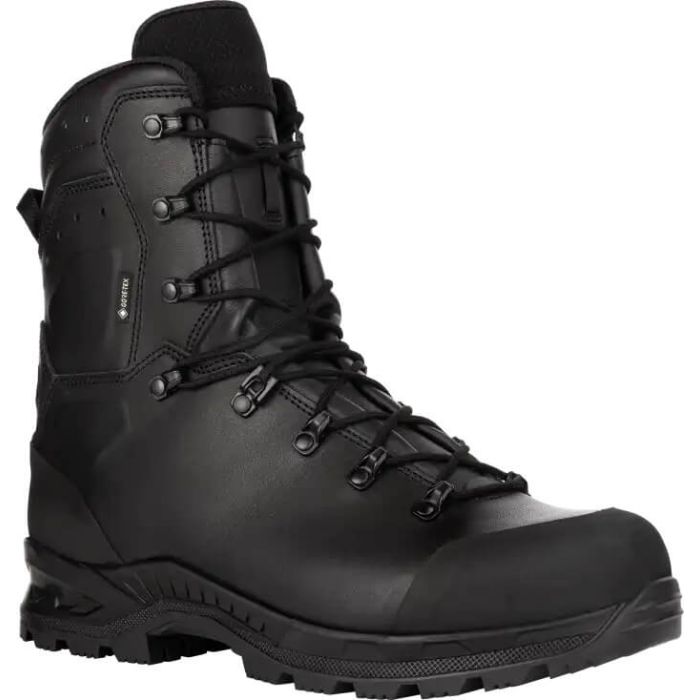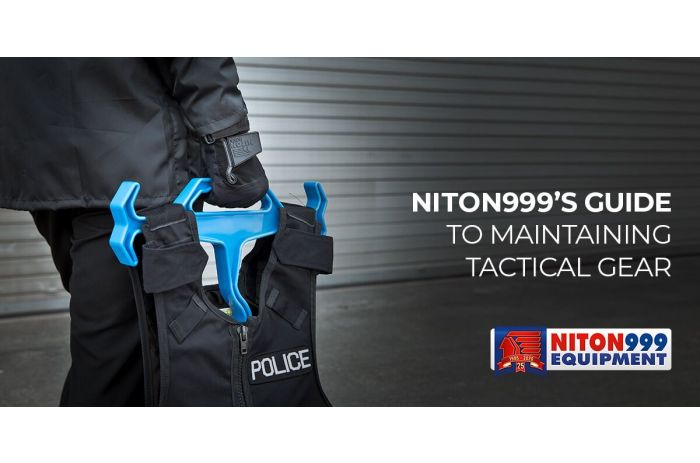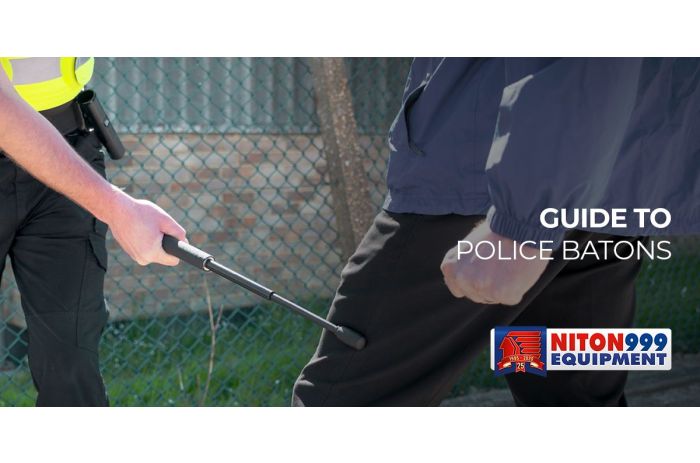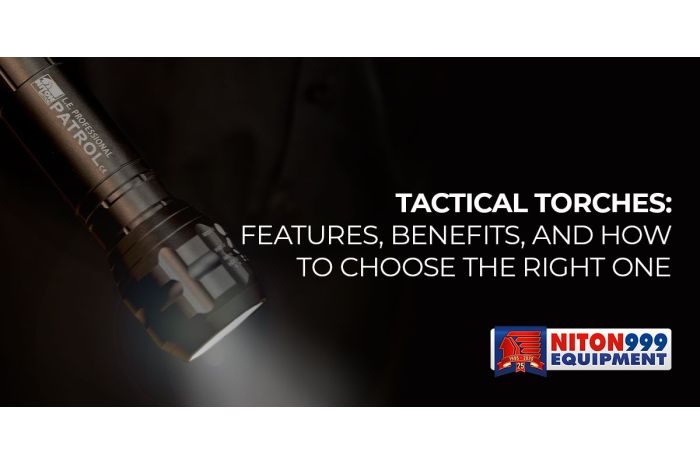Tactical gear is essential for law enforcement and military personnel, as well as outdoor enthusiasts, providing enhanced functionality, protection, and quick access to tools.
While tactical gear should be built to last in the face of enduring conditions, proper maintenance is crucial to ensure its longevity, performance and long-term reliability.
This guide will walk you through the essential steps to keep your tactical gear in top condition.
Understanding the Different Types of Tactical Gear
Before diving into maintenance, it's vital to understand the different types of tactical gear available.
This includes body armour, duty belts, tactical vests, footwear, gloves, protective eyewear, and communication devices, to name but a few.
Each item has unique maintenance needs based on its material and function.

Above: Niton999 Tactical Vest
Daily Maintenance
- Inspection: Conduct thorough inspections of your gear to identify any signs of wear, tear, damage, or any components that might be loose or malfunctioning. It’s crucial to catch any potential issues early on to prevent them from escalating into larger problems that could compromise the functionality and safety of your gear. Pay attention to stitches, seams and any areas that bear the most wear and tear during use.
- Cleaning: Regularly clean your gear to remove accumulated dirt, dust, grime, and sweat, which can degrade the material over time. Use a damp cloth, ensuring you reach all the nooks and crannies. Use a soft, dry cloth for electronic devices or components, and adhere strictly to the manufacturer’s cleaning guidelines to prevent accidental damage.
- Lubrication: Apply a proper lubricant to all moving parts, zippers, and snaps to ensure they operate smoothly. This not only ensures ease of use but also acts as a protective layer to prevent rust and corrosion, prolonging the lifespan of your gear.
Deep Cleaning Tactical Gear
Periodic in-depth cleaning is vital, especially if your gear has been subjected to harsh environmental conditions.
- Detach and Disassemble: Remove all removable components and, where possible, disassemble your gear to properly clean each part. This ensures that dirt, dust, and other contaminants are thoroughly removed, even from typically hard-to-reach areas.
- Use Appropriate Cleaners: Choose cleaning agents suitable for your gear's specific materials. Avoid using harsh or abrasive chemicals that could damage the fabrics, coatings, or any sensitive components.
- Air Dry: After cleaning, ensure your gear is completely air-dried before reassembling and storing it. This is crucial to prevent the growth of mould and mildew, which could degrade the material and potentially lead to health issues.
Proper Storage Solutions
Proper storage practices are crucial in maintaining the condition and extending the lifespan of your tactical gear.
- Cool, Dry Environment: Ensure that your gear is stored in a cool and dry space, away from direct sunlight and extreme temperatures, which can cause materials to degrade over time.
- Avoid Compression: Avoid stacking heavy items on top of your tactical gear, particularly body armour or other items that need to maintain their shape for functionality. Compression can alter the structure of these items and potentially reduce their effectiveness.
- Hang When Possible: Utilise hangers for items such as vests and belts. This helps maintain their shape, ensuring they remain functional and ready for use. Ensure the hangers and storage area are clean to prevent any potential dirt or dust accumulation on the gear.
Maintaining Tactical Clothing and Footwear
Tactical clothing and footwear are vital components for anyone involved in military, law enforcement, or other strenuous outdoor activities.

Above: Lowa tactical boots from Niton999
These pieces of equipment are designed to withstand tough conditions. However, they still require regular and meticulous care to ensure they remain in optimal condition and continue to provide the necessary protection and functionality.
- Follow Care Labels: Every piece of tactical clothing and footwear comes with specific care instructions provided by the manufacturer. It’s imperative that you adhere to these guidelines. The care labels guide you on how to properly wash, dry, and generally take care of your gear, ensuring that it maintains its integrity and functionality over time.
- Use Appropriate Cleaning Agents: When cleaning your tactical clothing and footwear, it’s important to select appropriate cleaning agents for the specific materials. Using the wrong type of cleaner can lead to material degradation, negatively affecting the gear’s performance and lifespan. For example, certain types of tactical footwear may require a special cleaner to preserve the waterproofing or other unique features.
- Proper Drying: Proper drying is crucial, particularly for footwear. Allow your boots to air dry and use boot dryers if necessary, ensuring they are not placed too close to high heat sources, as this can cause damage. Tactical clothing should also be dried according to the care instructions. Avoid high heat to preserve the material and any special features like waterproofing or fire resistance.
View our recommended police boots here.
Seasonal Maintenance: Preparing for Climate Changes
Tactical gear needs to be ready for all types of weather conditions, requiring adjustments in your maintenance routine to suit the changing seasons.
- Waterproofing: Before the onset of the rainy season, apply waterproofing agents to your gear, paying special attention to footwear and any other items that are particularly susceptible to water damage. This ensures your gear remains dry and functional, even in wet conditions.
- Condition Leather: Leather components of your gear, such as boots or gloves, must be conditioned before winter to prevent them from cracking in cold temperatures. This helps to maintain the material’s flexibility and prolongs its lifespan.
- Ventilation: In humid seasons, ensure that your gear is properly ventilated to prevent the growth of mould and mildew. Store your gear in a dry, well-ventilated area, and ensure it is completely dry before storing.
Summary: Your Tactical Gear Maintenance Checklist
Creating a comprehensive maintenance checklist is a proactive approach to tactical gear care.
Regular inspections, cleaning routines, lubrication, deep cleaning sessions and seasonal prep should all be included in this checklist.
By following these practices, you will significantly prolong the life of your gear, ensuring that it remains reliable functional and ready for action.
Niton999 stocks a wide range of patrol equipment and tactical gear, which you can find here.
FAQs
What is considered as tactical gear?
Tactical gear includes a broad range of equipment specifically designed for military, law enforcement, and outdoor activities. This encompasses body armour, holsters, belts, vests, footwear, gloves, communication devices, and other accessories designed to enhance performance and safety in the field.
How do you wash tactical gear?
Washing tactical gear requires careful attention to detail. Use a mild detergent and warm water, and opt for hand washing or a gentle machine cycle when applicable.
Always refer to and follow the manufacturer’s care instructions to ensure proper cleaning without damaging the gear.
Ensure that all gear is allowed to air dry completely before storing or reusing to maintain material integrity and prevent any issues related to dampness, such as mould or mildew.









